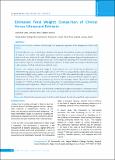Please use this identifier to cite or link to this item:
https://hdl.handle.net/20.500.14356/1622Full metadata record
| DC Field | Value | Language |
|---|---|---|
| dc.contributor.author | Joshi, Anshumala | - |
| dc.contributor.author | Panta, Om Biju | - |
| dc.contributor.author | Sharma, Basanta | - |
| dc.date.accessioned | 2023-05-16T10:27:07Z | - |
| dc.date.available | 2023-05-16T10:27:07Z | - |
| dc.date.issued | 2017 | - |
| dc.identifier.citation | JoshiA., PantaO. B., & SharmaB. (2017). Estimated Fetal Weight: Comparison of Clinical Versus Ultrasound Estimate. Journal of Nepal Health Research Council, 15(1). https://doi.org/10.33314/jnhrc.v15i1.971 | en_US |
| dc.identifier.issn | Print ISSN: 1727-5482; Online ISSN: 1999-6217 | - |
| dc.identifier.uri | http://103.69.126.140:8080/handle/20.500.14356/1622 | - |
| dc.description | Original Article | en_US |
| dc.description.abstract | Abstract Background: Accurate estimation of fetal weight is of paramount importance in the management of labour and delivery. Methods: This was a cross sectional study conducted over a period of 6 months in a tertiary care teaching hospital. All singleton term mothers with cephalic presentation and intact membranes with ultrasound examination done within a week were included in the study. IUFD, multiple gestation, malpresentation, diagnosed oligohydramnios or polyhydramnios, pelvic and or abdominal masses, and current weight more than 80 Kgs were excluded from the study. Expected fetal weight was estimated by clinical method (Johnson’s formula), which was compared with Ultrasound weight estimation (Hadlock method) and actual birth weight. Results: The estimated mean birth weight by clinical method was 3492.75±393.16g, by Ultrasound was 3230.02±407.22g and actual mean birth weight was 3236.32±472.87g. The estimated birth weight by ultrasonographic method showed slightly stronger positive correlation (r=0.54; p<0.001) with actual birth weight as compared to the clinical method (r=0.44; p<0.001). The error of estimation of weight by clinical method showed significant negative correlation (r=-0.24; p=0.01) with gestational age, however ultrasonographic method did not show significant correlation (r= +0.045; p=0.64). The sensitivity and specificity of clinical method and ultrasonographic method for identifying fetal birth weight above 3500 gm was 69.23; 65.67% and 46.15; 80.60%, respectively. Conclusions: Ultrasound was more reliable method to establish fetal weight at term and more consistent in various period of gestations. Clinical method can be reliably used to screen large babies in centers where ultrasound has limited availability. Keywords: Clinical fetal weight estimation; Hadlock’s method; Johnson’s formula; ultrasound fetal weight estimation. | en_US |
| dc.language.iso | en | en_US |
| dc.publisher | Nepal Health Research Council | en_US |
| dc.relation.ispartofseries | Jan-April, 2017;971 | - |
| dc.subject | Clinical fetal weight estimation | en_US |
| dc.subject | Hadlock’s method | en_US |
| dc.subject | Johnson’s formula | en_US |
| dc.subject | Ultrasound fetal weight estimation | en_US |
| dc.title | Estimated Fetal Weight: Comparison of Clinical Versus Ultrasound Estimate | en_US |
| dc.type | Journal Article | en_US |
| local.journal.category | Original Article | - |
| Appears in Collections: | Vol. 15 No. 1 Issue 35 Jan-Apr 2017 | |
Files in This Item:
| File | Description | Size | Format | |
|---|---|---|---|---|
| 971-Manuscript-1884-1-10-20170608.pdf | Fulltext Download | 255.45 kB | Adobe PDF |  View/Open |
Items in DSpace are protected by copyright, with all rights reserved, unless otherwise indicated.
